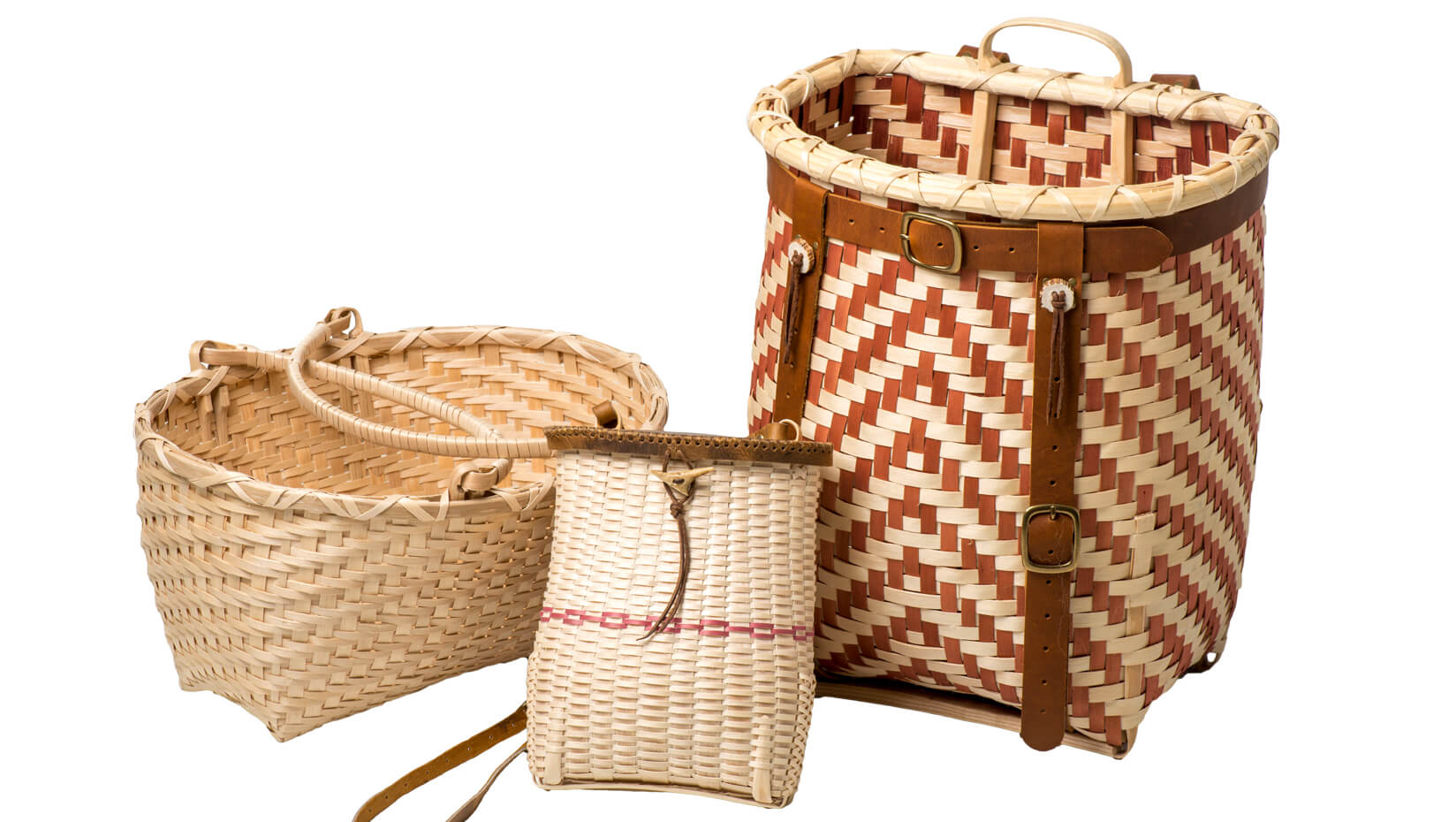
Frey, Greenlaw seek to preserve basketmaking, black ash trees
Gabriel Frey and Suzanne Greenlaw strive to honor the tradition, celebrate the present and preserve the future of basketmaking.
And the husband and wife will be selling baskets at the 22nd annual Maine Indian Basketmakers Holiday Market on Saturday, Dec. 10, in the Hudson Museum at the Collins Center for the Arts at the University of Maine.
Frey’s forte includes pack and utility baskets. The 13th-generation Passamaquoddy basketmaker integrates his style — including incorporating leather straps and leather liners — with techniques and lessons he learned from his grandfather, Fred Moore.
Functional, artistic pieces are the result.
In 1998, when Frey’s grandfather was diagnosed with emphysema, Frey went to stay with and learn from him in Pleasant Point. Then 18, Frey learned how to make tools, prepare black ash (sometimes called brown ash in Maine) wood strips and weave rugged baskets.
Today, Frey seeks to emulate the integrity of his grandfather’s approach and desire to build durable baskets. Frey says his grandfather, who fished and made baskets to provide for his family, was similar to a carpenter the way he worked with wood.
In native communities, Frey says brown ash materials often are children’s first toys, similar to wooden blocks in a carpenter’s house.
Basket weaving, he says, reflects indigenous Passamaquoddy values of connectivity and reciprocity between people and the environment.
Basketmakers form a relationship with the landscape, says Frey. Harvesters understand and interpret environmental cues to identify brown ash. They know which tree to choose in the stand and understand how their actions will affect future growth. Harvesters often revisit the same brown ash stands throughout their lifespan, he says.
Preserving future generations of black ash trees is a focus for Greenlaw, a doctoral student in the UMaine Senator George J. Mitchell Center for Sustainability Solutions and the School of Forest Resources and a member of the Maliseet tribe in Houlton. She also makes utility baskets and enjoys using natural dyes to add color to the creations.
For her doctoral research, Greenlaw is developing maps through GIS and remote sensing to predict where basket-quality black ash is likely to grow in the state; it’s estimated the species (Fraxinus nigra) comprises about 2–3 percent of Maine’s total forested land and, of that, about 5–20 percent is good for basketmaking.
As part of her research, Greenlaw is establishing an agreement between a commercial forest company and Wabanaki ash harvesters to permit basketmakers to harvest ash on private property.
Her research incorporates Wabanaki Traditional Ecological Knowledge and scientific knowledge to address Wabanaki cultural resource issues, including access and availability to brown ash and sweetgrass.
While conducting earlier research, Greenlaw met Frey’s brother, Jeremy, who suggested she and Frey should meet. He was right; five days after they met, they got engaged.
The project also involves collecting black ash seeds in advance of the emerald ash borer’s (EAB) arrival in Maine. EAB, a green beetle from China, has killed millions of ash trees in North America. Its presence has been confirmed in New Hampshire, a few miles from the Maine border.
While the EAB is a threat, Frey says native people have been and are incredibly resilient and will find a way to continue the craft.
Frey, Greenlaw and a number of other members of the Maine Indian Basketmakers Alliance — both national award-winning artists and members of the next generation — will showcase pieces at the free, public holiday market 9 a.m. to 3 p.m. Dec. 10. In addition to the one-of-a kind art forms that will be for sale, the event will include demonstrations, storytelling, traditional music, drumming and dancing.
“This year’s event is the 22nd holiday market at the Hudson Museum, which is held in partnership with the Maine Indian Basketmakers Alliance,” says Gretchen Faulkner, director of the Hudson Museum. “The day is not just a sale, but for the public it is a rare opportunity to purchase art directly from Maine Indian artists and to learn first-hand about these ancient traditions.”
The Dec. 10 schedule includes:
- 10 a.m. — Welcome ceremony
- 10:30 a.m.— Traditional Penobscot songs with Penobscot Kelly Demmons
- 11 a.m. — Brown ash-pounding demonstration with Micmac Eldon Hanning
- 11:30 a.m. — Children’s bookmark and sweetgrass braiding workshop with Penobscot Pam Cunningham, Hudson Museum’s Maine Indian Gallery
- Noon — Fancy basket demonstration with Passamaquoddy Peter Neptune
- 12:30 p.m. — Drumming and singing with Penobscot Chris Sockalexis
- 1 p.m. — Birchbark demonstration with Penobscot Barry Dana
- 1:30 p.m. — Storytelling with Passamaquoddy George Neptune, Hudson Museum’s Maine Indian Gallery
- 2 p.m. — Burnurwurbskek Singers
- 3 p.m. — Raffle drawing for the Hudson Museum Friends basket made by Maliseet master basketmaker Fred Tomah (Tickets, $5 each, may be purchased at the holiday market or at the Hudson Museum prior the event.)
Contact: Beth Staples, 207.581.3777
